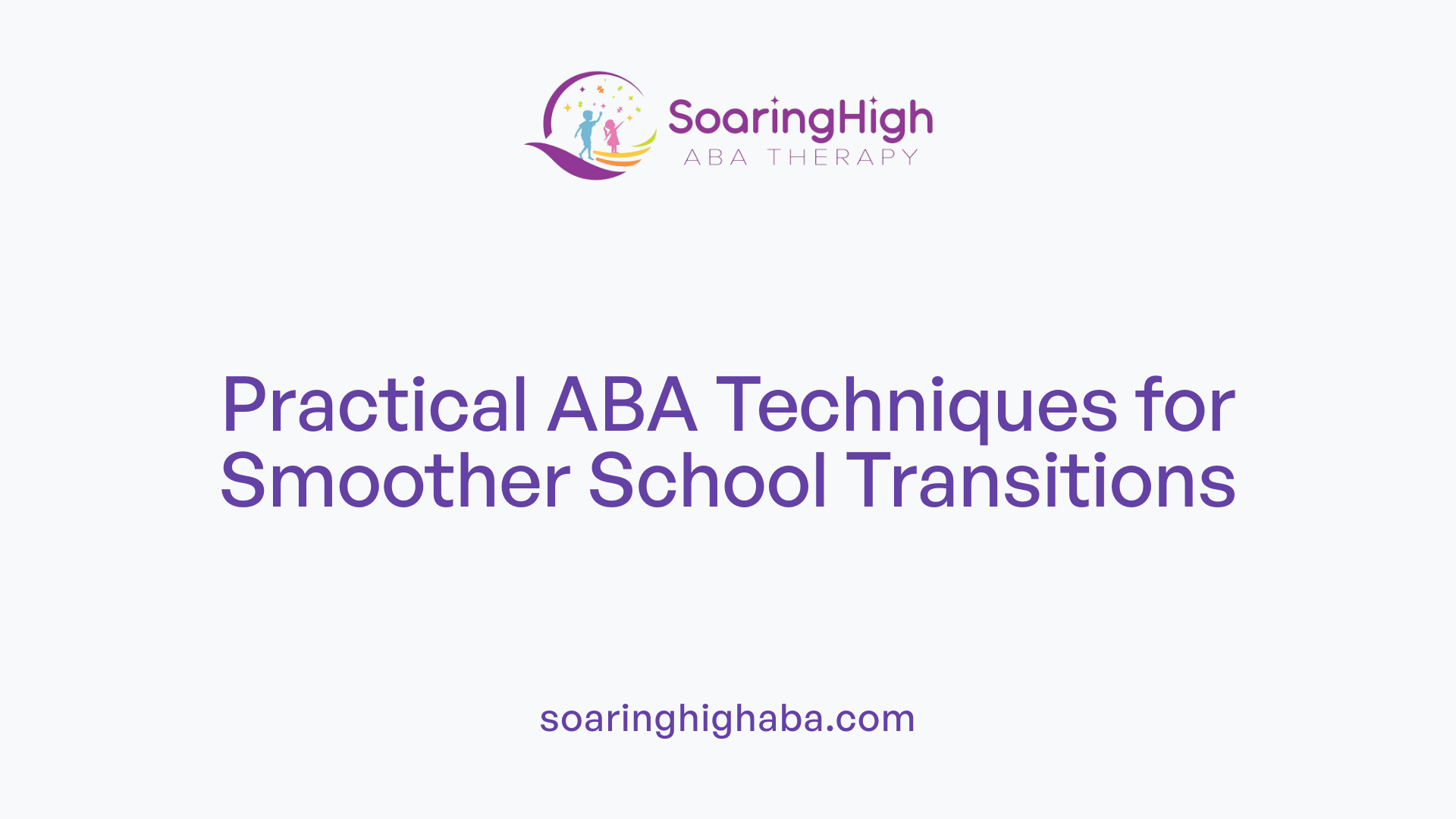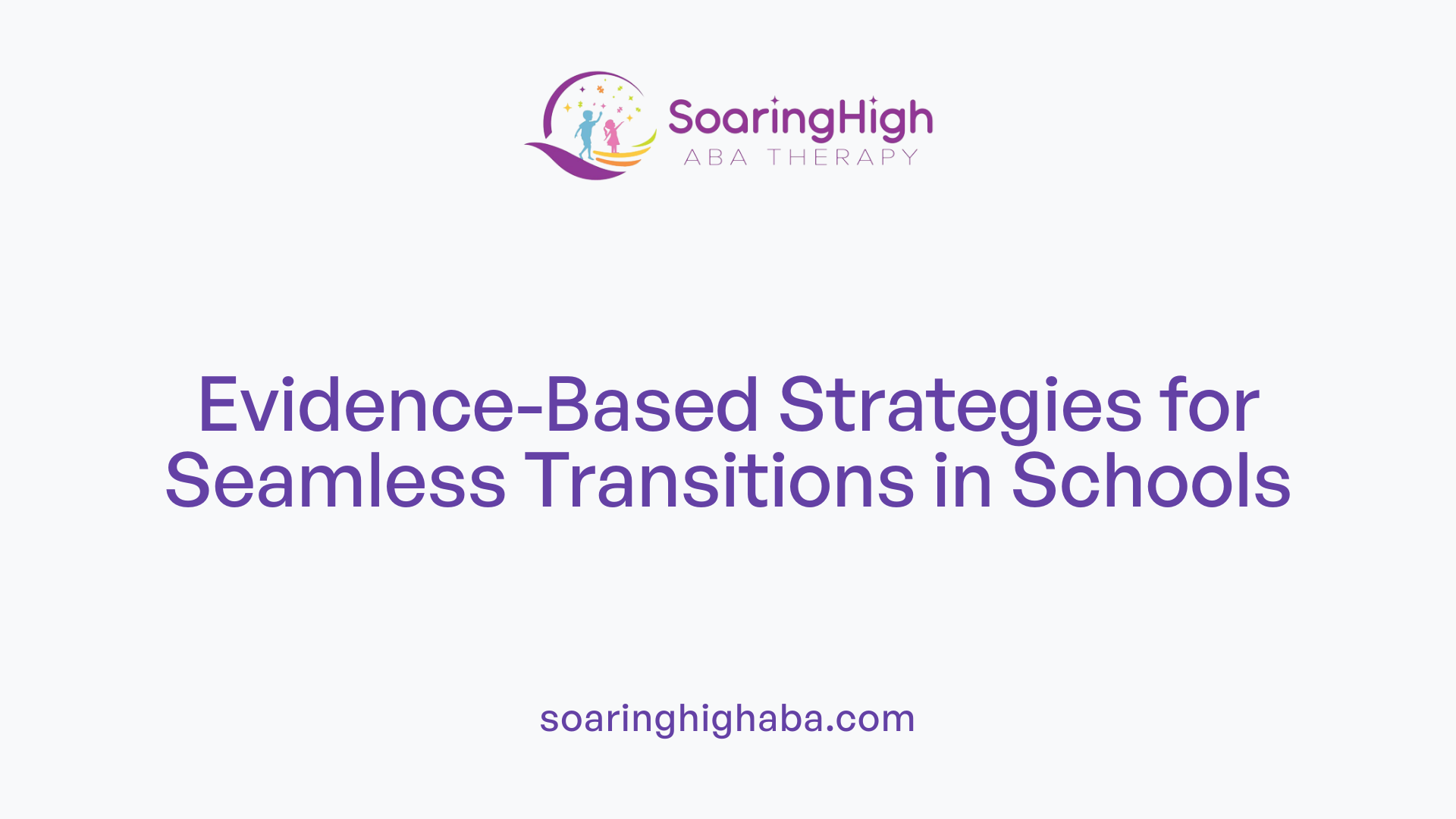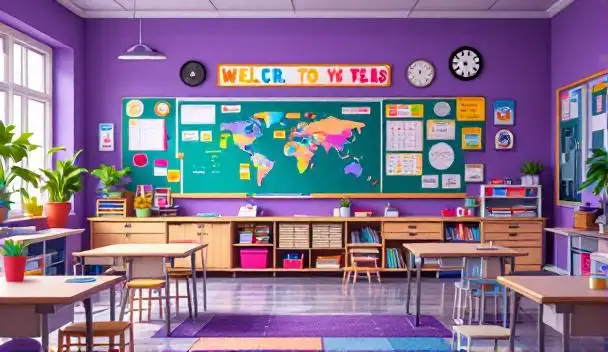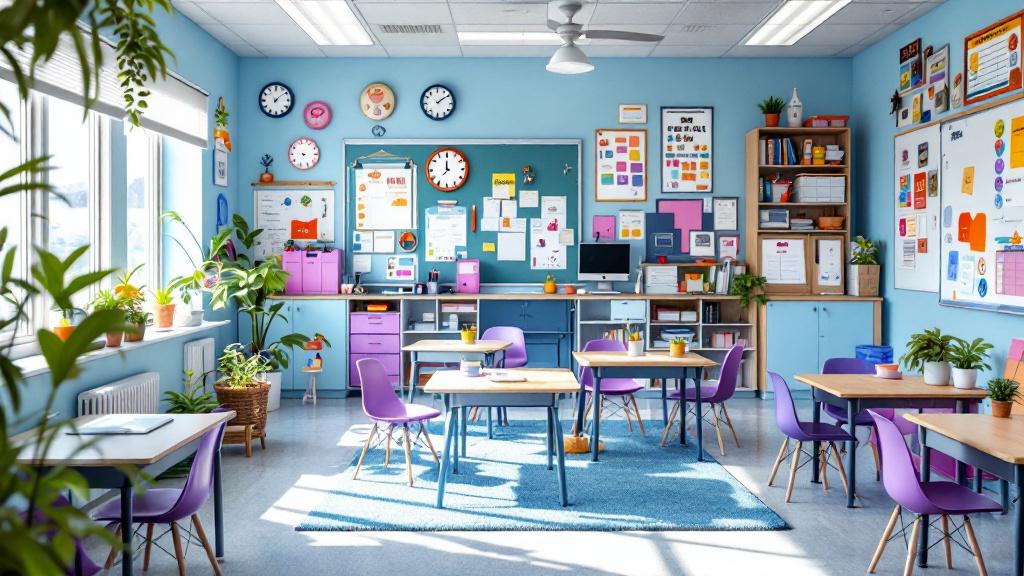Enhancing Transition Success through Behavioral Support
School transitions are pivotal moments that can significantly impact a child's learning experience, especially for students with autism spectrum disorders and other disabilities. Applying Applied Behavior Analysis (ABA) within the school environment offers a structured, individualized approach to foster positive behaviors and reduce anxiety during these critical periods. By incorporating visual supports, consistent routines, and collaboration among educators, therapists, and families, schools can create a predictable and supportive atmosphere that promotes social, behavioral, and academic development.
Integrating ABA in School Environments to Promote Holistic Development

How is ABA therapy integrated into school settings to support children's behavioral, social, and academic development during transitions?
Applying Applied Behavior Analysis (ABA) within schools creates a supportive environment that fosters growth in multiple areas for children, especially those with autism and developmental challenges. One core strategy is the use of visual supports, like schedules, social stories, and timers, which help students understand and predict what will happen next. These tools reduce anxiety and promote independence by making routines more concrete.
Preparation before transitions plays a vital role. Schools might arrange visits, run practice sessions, or use role-playing activities to familiarize children with upcoming changes. This step-by-step exposure helps children build confidence and reduced uncertainty. During transitions, incorporating calming strategies and tools—such as sensory toys, breathing exercises, or comfort items—can assist children in regulating their emotions and managing stress.
Collaboration among educators, therapists, and families ensures these strategies are consistent and tailored to each child's needs. Developing individualized transition plans that incorporate ABA techniques guarantees a cohesive approach. Consistently reinforcing positive behaviors and teaching functional communication skills enable children to adapt more successfully, participate actively, and develop social competence.
Overall, embedding ABA strategies into everyday school routines supports a comprehensive developmental process, helping children navigate academic tasks, social interactions, and life transitions effectively.
Effective ABA Strategies for Managing Transitions

How can visual schedules and consistency in routines help facilitate smooth school transitions?
Visual schedules and supports serve as clear, predictable guides for children, outlining upcoming activities and routines. These visual tools—such as picture schedules, 'now and next' boards, and social stories—assist children in understanding what to expect and prepare mentally and emotionally for upcoming changes. Consistent routines reinforce behavioral expectations and foster a sense of stability, which can significantly reduce anxiety associated with transitions.
Using visual cues alongside auditory signals or rewards can further engage multiple senses, motivating students to cooperate during changeovers. This combination of strategies supports independence, minimizes disruptive behaviors, and makes navigating school routines more manageable for students, especially those with autism or other developmental challenges.
Overall, incorporating visual supports and maintaining routine consistency creates a supportive environment that eases transitions, helping students feel more secure and confident during periods of change.
What are effective strategies for supporting positive behavior during school transitions using ABA techniques?
To promote positive behavior during transitions, ABA practitioners implement several proactive strategies. Visual supports, like schedules and social stories, prepare children in advance by reducing uncertainty and anxiety. Functional Communication Training (FCT) teaches students to express their needs and requests appropriately, decreasing behaviors that might arise from frustration.
Clear expectations and positive reinforcement are central to these strategies. Transition warnings, visual cues, and prompts help prepare students for upcoming changes, preventing problematic behaviors before they start. Teaching flexibility—such as gradually exposing students to change, offering choices, and reinforcing adaptable responses—further aids in smooth transitions.
Developing individualized Behavior Intervention Plans (BIPs) that incorporate these techniques, along with parent training and modifications to the environment, can significantly improve transition success. These strategies collectively foster a calm, cooperative atmosphere that supports learning and reduces stress.
What are the benefits of ABA for students with autism spectrum disorders and other disabilities during transitions?
ABA provides vital support for students with autism spectrum disorders (ASD) and other disabilities during transitions by fostering greater adaptability, independence, and social skills. Customized, evidence-based interventions—such as visual schedules, social stories, and transition-specific cues—make changes predictable and less stressful.
These strategies help children respond appropriately to prompts and participate actively in routines, which reduces anxiety and disruptive behaviors. By teaching essential communication, self-regulation, and daily living skills, ABA facilitates smoother transitions across various settings, including school, community activities, and post-secondary environments.
The data-driven nature of ABA allows for continual monitoring and adjustment, ensuring interventions are effective and tailored to each child's evolving needs. Ultimately, ABA enhances overall functioning and empowers children to manage transitions more successfully, promoting positive long-term outcomes and increased independence.
| Strategies in Practice | Techniques Used | Benefits |
|---|---|---|
| Visual Schedules | Picture schedules, social stories, 'now and next' boards | Increased predictability, reduced anxiety, enhanced independence |
| Communication Supports | Functional Communication Training (FCT), social stories | Better expression of needs, fewer challenging behaviors |
| Behavioral Prompts | Transition warnings, visual cues, positive reinforcement | Smoother changeovers, decreased disruptive behaviors |
| Teaching Flexibility | Gradual exposure, offering choices, reinforcing adaptability | Increased resilience, greater engagement |
| Customized Interventions | Individualized Behavior Intervention Plans (BIPs), parent training | Tailored support, improved overall transition success |
By integrating these methods, educators and therapists can create a structured, supportive environment that helps students with diverse needs navigate complex transition periods with confidence and ease.
Supporting Teacher and Caregiver Implementation of ABA Techniques

What educational guidance can be provided to teachers, interventionists, and caregivers for implementing ABA-based support during school transitions?
Implementing ABA techniques during school transitions requires thorough training for teachers, interventionists, and caregivers. This training should cover core ABA strategies such as positive reinforcement, data collection, natural environment teaching (NET), and the use of visual supports.
Visual supports are particularly effective in helping children anticipate changes and understand upcoming routines. These might include visual schedules, social stories, and countdowns that prepare students for transitions between activities or settings. Creating individualized transition plans tailored to each child's needs ensures that support is relevant and effective.
Embedding transition goals within everyday routines, like singing a song before moving to a new activity or using specific cues to signal change, helps children develop consistency and reduce anxiety. When children can predict what will happen next, their confidence and independence grow.
Facilitating social interactions by pairing students with peers or using structured activities encourages cooperation and fosters social skills. This environment should be positive and supportive, helping children generalize behaviors and skills across different settings.
Ongoing reinforcement plays a crucial role. Praising children for successful transitions and providing rewards helps motivate continued good behavior. It’s also important to prepare for and implement strategies that address problematic behaviors or challenges during transitions.
In addition to training, continuous collaboration among educators, interventionists, and caregivers ensures strategies remain effective and adaptable. Regular monitoring and data collection allow for adjustments to be made, ensuring each child's needs are met.
Overall, comprehensive guidance and tailored support are vital in helping children navigate school transitions confidently and successfully. These practices not only support immediate school success but also promote long-term skill development and emotional resilience.
| Aspect | Methods | Details |
|---|---|---|
| Training focus | ABA principles | Reinforcement, data collection, NET |
| Visual supports | Schedules, stories, countdowns | Help anticipate changes |
| Personalization | Transition plans | Tailored to each child’s needs |
| Routine embedding | Incorporating cues | Songs, signals for smooth change |
| Social engagement | Peer pairing | Encourages cooperation |
| Reinforcement | Praise and rewards | Promotes independence |
| Collaboration | Ongoing communication | Between teachers, interventionists, caregivers |
| Monitoring | Data collection | Adjust strategies as needed |
By applying these comprehensive strategies, educators and caregivers can significantly ease the transition process for students with autism spectrum disorder (ASD) and other developmental challenges, fostering a supportive environment that promotes growth and learning.
The Role of Data and Progress Monitoring in ABA-supported Transitions

How can ABA therapy be integrated into school settings to support children's behavioral, social, and academic development during transitions?
ABA therapy plays a crucial role in easing children’s transitions within school environments. It uses visual supports like schedules, social stories, and timers, which help children understand upcoming changes and create predictable routines. This predictability can significantly reduce anxiety and increase comfort. During transition periods, such as moving from one activity to another or entering a new environment, preparation strategies like visits, practice role-plays, and gradual exposure are employed to help children become familiar and confident.
Supporting emotional regulation is also vital. Techniques such as calming tools, validating feelings, and allowing comfort items assist children in managing their stress levels. Additionally, collaboration among ABA therapists, teachers, and parents is essential. Developing individualized transition plans tailored to each child's needs ensures consistency and fosters a supportive atmosphere.
Positive reinforcement of adaptive behaviors and instruction in functional communication further prepare children for successful adaptation. These strategies facilitate not only smoother transitions but also promote independence and social engagement in school settings.
Continuous data collection and analysis
A cornerstone of effective ABA-supported transitions is ongoing data collection and analysis. Therapists and educators gather detailed information on the child’s behaviors, responses, and progress during each transition. This data includes frequency of specific behaviors, time taken to adjust, and the child's emotional state. Reliable and precise data collection allows for an objective assessment of what strategies are effective.
By analyzing this data regularly, the team can identify patterns or areas needing improvement. For example, if a child consistently exhibits high anxiety during transitions, additional supports or modified approaches can be implemented.
Progress monitoring also involves tracking skill acquisition such as self-regulation, communication, and social interaction. Continuous data helps ensure that interventions are tailored, effective, and evolving based on the child's developmental trajectory.
Adjusting interventions based on outcomes
Data-driven insights support timely adjustments to ABA interventions. If monitoring indicates limited progress or unexpected behaviors, the intervention plan may be modified. This could include increasing visual supports, modifying reinforcement strategies, or introducing new coping skills.
Adjustments are made collaboratively, involving the entire team—teachers, therapists, and families—to ensure consistency across settings. This flexibility ensures that each child’s unique needs are addressed, leading to more positive and sustainable outcomes.
The iterative process of data collection, analysis, and intervention refinement embodies the responsive nature of ABA, ensuring that transition support continuously aligns with the child's evolving abilities.
| Aspect of Monitoring | Description | Purpose |
|---|---|---|
| Data Collection Methods | Observations, checklists, video recordings, and behavioral logs | To gather accurate, real-time information about behaviors and responses |
| Data Analysis Techniques | Trend analysis, graphing, and pattern recognition | To interpret information and identify needs |
| Intervention Adjustments | Changes in reinforcement, visual supports, or teaching procedures | To enhance effectiveness of transition strategies |
| Outcomes Measured | Behavior frequency, emotional regulation, social engagement, skill development | To evaluate success and inform future planning |
How does continuous monitoring impact the overall success of ABA-supported transitions?
Ongoing data tracking ensures that every decision about transition support is evidence-based. It helps identify what works well and where improvements are needed. This responsiveness fosters a dynamic learning environment, with interventions refined on the go. Ultimately, it increases the likelihood of positive experiences for children, encouraging independence and confidence in navigating school routines.
Building a Supportive Environment for Successful Transitions

What evidence-based practices can schools implement to aid smooth transitions for children with diverse needs?
Supporting children with diverse needs, especially those with autism spectrum disorder (ASD) or developmental challenges, requires deliberate and tailored strategies within the school environment. Evidence-based practices such as Applied Behavior Analysis (ABA), Cognitive Behavioral Therapy (CBT), and Dialectical Behavior Therapy (DBT) provide foundational frameworks for creating positive, adaptive experiences for students.
All Together ABA is an organization that specializes in offering personalized interventions grounded in these proven methods. Their approach integrates natural environment teaching (NET), which uses the child's everyday surroundings as a platform for developing new skills and fostering independence.
Schools aiming to facilitate smoother transitions for their students often incorporate modifications that align with these practices. Some effective strategies include:
- Designating Calming Areas: Establish quiet zones where students can retreat to manage sensory overload or emotional distress.
- Visual Cues and Supports: Use visual schedules, social stories, or picture cues to prepare students for upcoming changes or activities.
- Routine Consistency: Maintain predictable routines while gradually introducing variation to help students adjust comfortably.
- Environmental Modifications: Arrange the physical space to be engaging yet non-overstimulating, with designated areas for different activities.
These modifications foster a safe, predictable, and engaging learning environment. When children understand what to expect and feel supported, they are more likely to adapt successfully to routine changes, new settings, or transitions within the school day.
Moreover, partnerships with families, educators, and community members enhance the effectiveness of these interventions. Multidisciplinary collaboration ensures that strategies are consistent across environments, which is crucial for generalizing skills and promoting independence.
How does the emphasis on individualized and holistic support influence transition success?
Individualized support begins with thorough assessments of each child's strengths and challenges. Collaboratively developing and adapting transition plans can address specific needs effectively. This includes establishing clear goals, implementing customized routines, and providing targeted behavioral support.
Holistic support involves addressing not only academic skills but also social-emotional and behavioral aspects. Techniques such as positive reinforcement encourage desirable behaviors, while data collection helps monitor progress and inform necessary adjustments.
Ultimately, integrating tailored interventions and natural environment teaching into daily routines enhances the child's confidence and competence in new or changing settings, making transitions smoother and more successful.
Fostering Success with Tailored Behavioral Strategies
Implementing ABA strategies during school transitions creates a structured, predictable, and supportive environment that facilitates positive behaviors and emotional well-being. Collaboration among educators, therapists, and families ensures that interventions are individualized and comprehensive, promoting a smooth transition for children with diverse needs. Utilizing visual supports, consistent routines, data monitoring, and environmental adaptations enhances children's confidence and independence, leading to improved social, behavioral, and academic outcomes. Embracing these evidence-based practices empowers schools to nurture resilient learners capable of navigating life's changes successfully.
References
- School-Based ABA Therapy in Maryland & Virginia
- Enhancing Mental Health: How Behavioral Therapy from ...
- Policy/Program Memorandum 140 | Education in Ontario
- Autism Transition Strategies: Helping Children Adapt with ...
- Back-to-School Prep: Using ABA Strategies to Support ...
- ABA Therapy Techniques to Help Your Child Handle Change
- Making Transitions Easier: ABA Tools for Everyday Routines
- How ABA Therapy Can Support Back-to-School Routines
- Applied Behavior Analysis (ABA)
- The Top 10 Reasons Children With Autism Deserve ABA





































































































